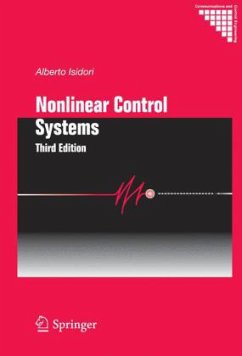This established and authoritative text focuses on the design and analysis of nonlinear control systems. The author considers the latest research results and techniques in this updated and extended edition. Examples are given from mechanical, electrical and aerospace engineering. The approach consists of a rigorous mathematical formulation of control problems and respective methods of solution. The two appendices outline the most important concepts of differential geometry and present some specific findings not often found in other standard works. The book is, therefore, suitable both as a graduate and undergraduate text and as a source for reference.
This book introduces nonlinear control systems at a level suitable for graduate students and researchers. Chapter 1 introduces invariant distributions, a fundamental tool in the analysis of the internal structure of nonlinear systems. It is shown that a nonlinear system locally exhibits decompositions into parts similar to those introduced by Kalman for linear systems. Chapter 2 explains to what extent global decompositions may exist, corresponding to a partition of the whole state space into lower dimensional subsets. Chapter 3 describes various formats in which the input-output map of a nonlinear system may be represented, and provides a short description of the fundamentals of realization theory.
Chapter 4 illustrates how a series of relevant design problems can be solved for a single-input single-output nonlinear system. It explains how a system can be transformed into a linear and controllable one, discusses the role of the nonlinear analogue of the notion of "zero", and describes the problem of asymptotic tracking, model matching and disturbance decoupling. Chapter 5 covers similar subjects for those multivariable nonlinear systems which can be rendered noninteractive by means of static state feedback, and Chapters 6 and 7 are devoted to control via dynamic feedback for a broader class of multivariable nonlinear systems. The book was first published in 1985 as Volume 72 in the series Lecture Notes in Control and Information Sciences. The new edition has been thoroughly revised and furnished with examples and exercises at the end of each chapter.
Hinweis: Dieser Artikel kann nur an eine deutsche Lieferadresse ausgeliefert werden.
This book introduces nonlinear control systems at a level suitable for graduate students and researchers. Chapter 1 introduces invariant distributions, a fundamental tool in the analysis of the internal structure of nonlinear systems. It is shown that a nonlinear system locally exhibits decompositions into parts similar to those introduced by Kalman for linear systems. Chapter 2 explains to what extent global decompositions may exist, corresponding to a partition of the whole state space into lower dimensional subsets. Chapter 3 describes various formats in which the input-output map of a nonlinear system may be represented, and provides a short description of the fundamentals of realization theory.
Chapter 4 illustrates how a series of relevant design problems can be solved for a single-input single-output nonlinear system. It explains how a system can be transformed into a linear and controllable one, discusses the role of the nonlinear analogue of the notion of "zero", and describes the problem of asymptotic tracking, model matching and disturbance decoupling. Chapter 5 covers similar subjects for those multivariable nonlinear systems which can be rendered noninteractive by means of static state feedback, and Chapters 6 and 7 are devoted to control via dynamic feedback for a broader class of multivariable nonlinear systems. The book was first published in 1985 as Volume 72 in the series Lecture Notes in Control and Information Sciences. The new edition has been thoroughly revised and furnished with examples and exercises at the end of each chapter.
Hinweis: Dieser Artikel kann nur an eine deutsche Lieferadresse ausgeliefert werden.
From the reviews:
Isidori's book is essential for anyone preparing for serious reading or basic research in the differential geometric approach to control theory and will not disappoint those mathematically trained. I have observed its use in the hands of two teachers other than the author; the students enjoyed it and made good use of it later. There is no universal solvent for nonlinear control problems, but the methods presented here are powerful.
IEEE Transactions on Automatic Control 43 (1997) 1043-1044 (Reviewer: David L. Elliott)
Isidori's book is essential for anyone preparing for serious reading or basic research in the differential geometric approach to control theory and will not disappoint those mathematically trained. I have observed its use in the hands of two teachers other than the author; the students enjoyed it and made good use of it later. There is no universal solvent for nonlinear control problems, but the methods presented here are powerful.
IEEE Transactions on Automatic Control 43 (1997) 1043-1044 (Reviewer: David L. Elliott)

